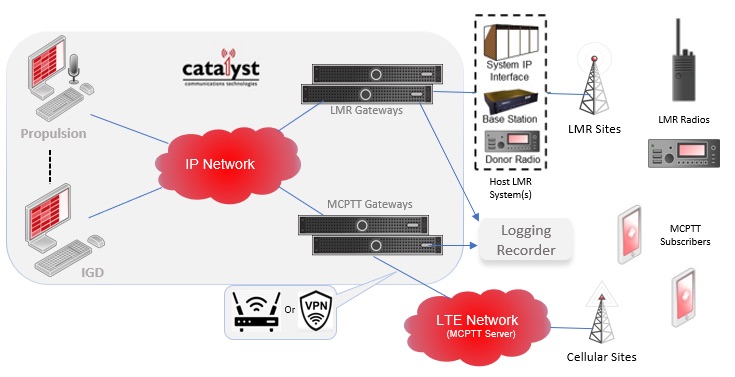Catalyst’s system architecture is designed to provide fault tolerance, system flexibility, ease of use, and ease of system maintainability. This architecture employs a distributed computer networking model which eliminates the need for a centralized switch, thus minimizing the impact of failure of any system component.
Each Catalyst system is built with one or more state-of-the-art radio gateways. These gateways are the system “workstations” in the Catalyst architecture. Gateways are specific to the radio system or other communication system being supported. However, any mixture of gateways can be included to meet the customers’ specific needs. For example, a system may consist of three L3Harris Project 25 (P25) gateways, two P25 conventional or trunked Digital Fixed Station Interface (DFSI) gateways, a Long Term Evolution (LTE) Mission Critical Push-To-Talk (MCPTT) gateway, and a Session Initiation Protocol (SIP) telephony gateway. The Catalyst architecture brings together each of these different communications gateways for dispatch and interoperability.
Each system also contains one or more of Catalyst’s Console applications. The console applications are the user interface of the system. Our flagship Dispatch Console is Propulsion™, a fully featured public safety grade dispatch console. We also provide Desktop Dispatch™, a “lite” dispatch PC application, and various application specific user interfaces for Incident Command and interworking / interoperability management.
All consoles and gateways in a Catalyst system communicate via an Internet Protocol (IP) network which may be a Local Area Network (LAN) or Wide Area Network (WAN). The Catalyst portfolio has been carefully engineered to be network friendly, an advantage that should not be underestimated when comparing Catalyst to competitive solutions.
Figure 1 provides a high-level architectural overview of the Catalyst solution.
For a more comprehensive overview of Catalyst Architecture, the wide variety of radio system Gateways available from Catalyst, and a description of the Dispatch and Interoperability client user interfaces that control these systems, download the System Architecture description HERE.


